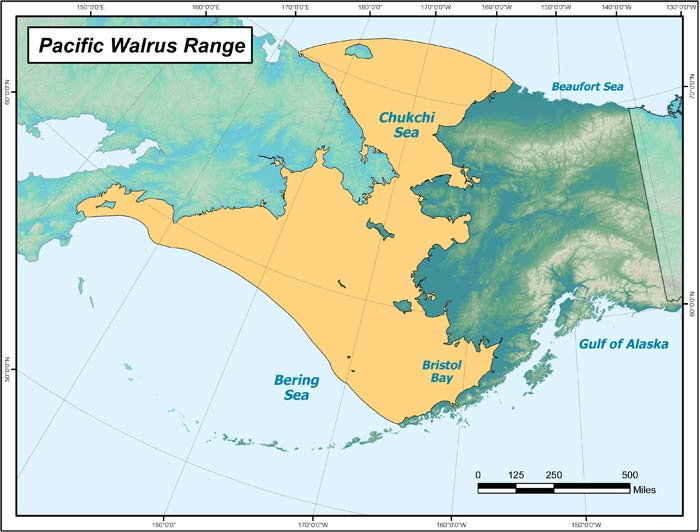 |
| In an effort to prevent walrus from being panicked and crushing their calves, the U.S. is putting into place measures to protect the moustachioed wildlife (HERE). |
NOAA Fisheries originated a recent story about a near-shore aggregation of walruses off the coast of NW Alaska (actual survey data and photos HERE). The site at Point Lay is known as a beach haul-out area from recent surveys. Point Lay is also considered to be one of the last original settlements of the Kuukpaagruk people. The Walrus has been a part of their lives for centuries. This species has gone through some very difficult periods. Hunted almost into extinction, the species has re-established itself across its range in the Bering Strait. Last significant census was of very poor quality, and a wide range of population estimates (aerial survey 2006). Alaska Fish and Game completed a status report in 2011 in response to a petition to list the walrus as endangered or threatened.
 |
| Alaska Fish and Game (Source) |
I find it interesting that, throughout much of the status report, references to uncertainty, and the lack of reliable data are prevalent. And then Executive Summary concludes by saying the continued monitoring of status and trends will be important to best manage these (almost completely unknown) populations of Pacific Walrus. What is 'continued' about poor access to lousy data? This same location is stated to have seen 30,000 beached walruses in 2011.
Wildlife populations are inherently difficult to understand. They are massively complex systems that are very dynamic in response to a whole host of different factors. And how those factors interact is complex in itself. There are no bailouts in nature ~
The climate and resultant habitat changes that are currently being blamed for this massive aggregation of walruses may very well be a good portion of the problem. There does appear to be a shift in habitat usage to near-shore habitats with reduced ice. While shifts in habitat use might be somewhat anticipated, beach haul-outs are not.
 |
| Photo Credit NOAA Fisheries (Larger version HERE) |
Walrus beach haul-outs in Alaska are not historical. These areas are important to locate as they provide valuable information for managing aircraft and shipping travel. Walrus are sensitive to disturbance during these haul-out events - and remember, they are intended as 'rest' events.
Whether we are measuring trends and status over generations, centuries or eons, variation is the basis to life. Life requires the dynamics that make it up. Diversity and dynamism go hand in hand. However, we have to remember also that man-made perturbations add to other natural perturbations.
The population of Pacific Walrus in the Bering and Chukchi seas may have peaked in the 90's after growing consistently from the 60's (Alaska Dept. of fish and Game). Across most species, cumulative effects of natural and man-made changes can have very significant implications to their survivability. And with the recent onset of the first commercial traffic through the Northwest Passage, additional man-made perturbations will continue for the Pacific Walrus.

The Community
Perched on the Chukchi Sea coast 150 miles southwest of Barrow, Point Lay is protected from the open ocean by the Kasugaluk Lagoon. The Eskimo name for the village is Kali, which means 'mound' and refers to the elevated ground on which it stands. It is probably the last remaining village of the Kuukpaagruk people. The deeply indented shoreline prevented effective bowhead whaling and the village never fully participated in the whaling culture. The village's traditional hunt of the beluga whales is similar to the bowhead whaling culture in other North Slope villages.
Point Lay is incorporated as an Native village by the Bureau of Indian Affairs under the Indian Reorganization Act. The village is not incorporated under state law as a municipality.
Population and Economy
Point Lay had a population of 260 residents in 2003, with a work force of 98. Eighty-six percent of residents are Inupiat Eskimo. Point Lay's economy is primarily based on subsistence hunting, fishing and whaling. The North Slope Borough employs 29 percent of the labor force and the School District employs another 34 percent. Twenty-nine percent of workers are in the private sector, mostly for the village and regional Native corporations.
Quality of Life
As in other villages, the North Slope Borough provides public electricity and piped water/wastewater services. Trash pick-up is also provided by the borough.
A health clinic, staffed by community health aides, is open daily and is accessible for emergencies around the clock. Other public facilities include a cultural center, construction camp, and a fire station equipped with a fire engine and an ambulance. Point Lay's Cully School provides education from pre-school through grade 12, as well as adult basic education.
The Native Village of Point Lay owns the local store, which sells groceries and clothing. Available fuel in town includes propane, diesel and regular gasoline. Point Lay bans the sale, possession and importation of alcoholic beverages.
Passenger service to Point Lay is available by scheduled airline flights and charters from Barrow. Freight is delivered by air and barge. Communications in the village include phones, mail, public radio and cable TV.
For recreation, residents enjoy snowmobiling, hunting, fishing and trapping.
For more information contact:
Native Village of Point Lay
P.O. Box 59
Point Lay, Alaska 99759
(907) 833-2428
No comments:
Post a Comment